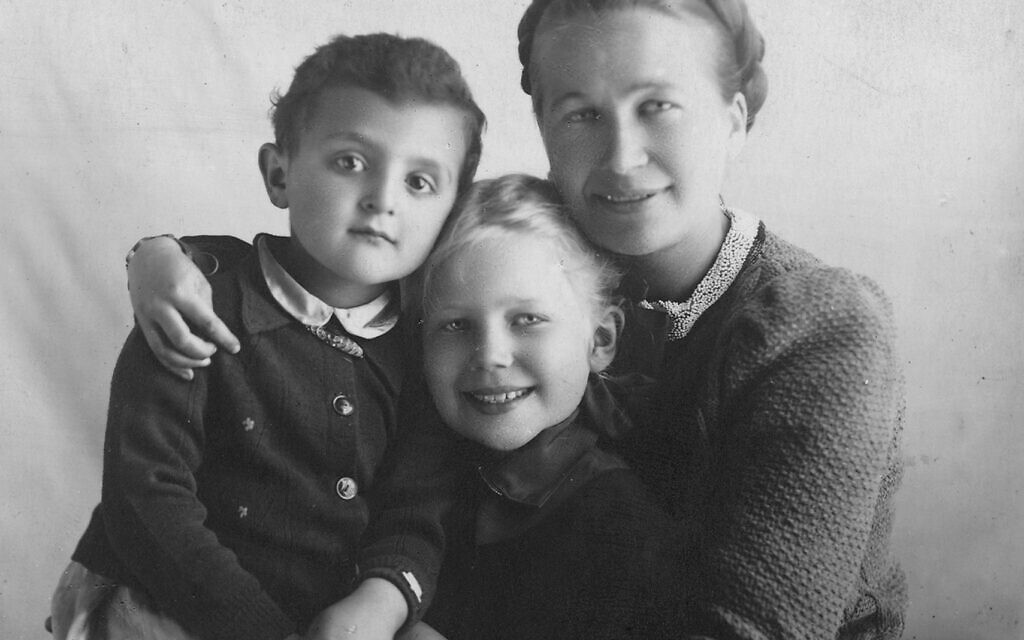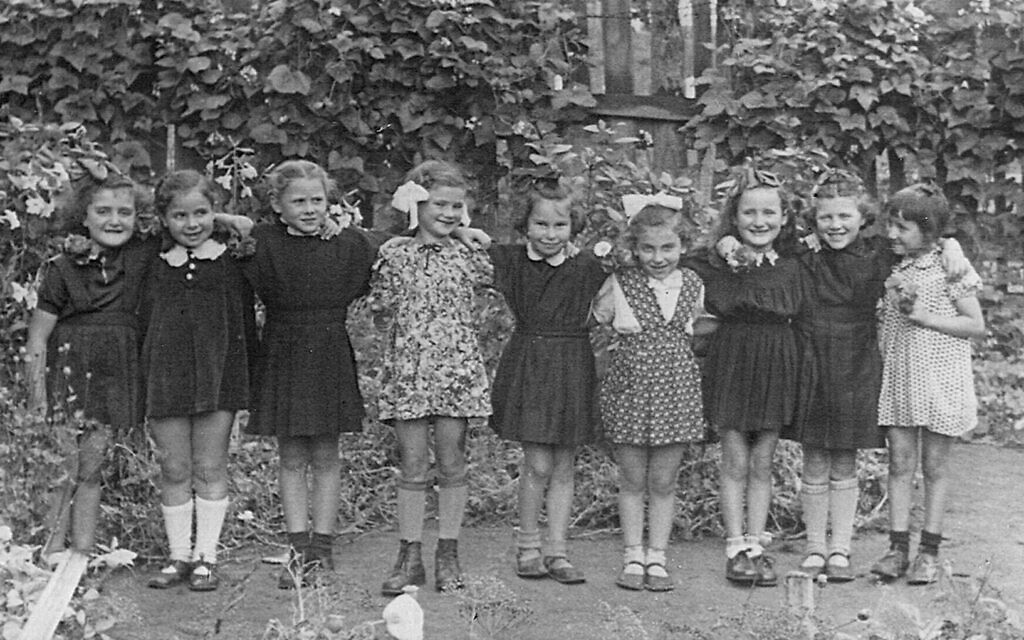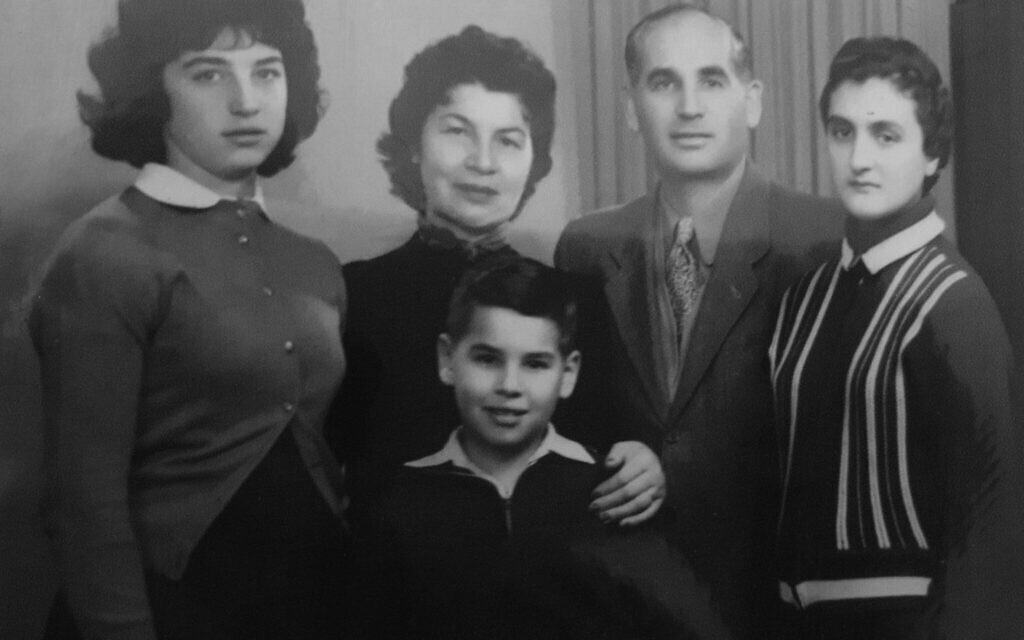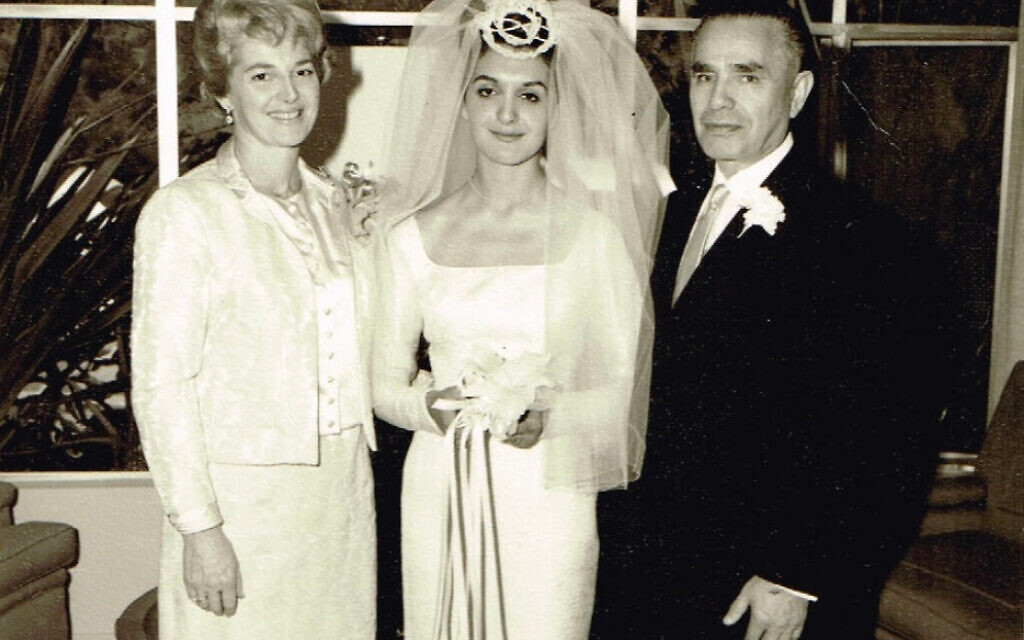The amazing true story of a baby illegally born and smuggled out of Kovno ghetto
Elida Freidman Goldberg Katzman changed names, families, countries and continents numerous times as she grappled until her premature death with being a Holocaust orphan from birth
 A very young Elida (left) with Stanislava and her daughter Audra, who hid Elida (renamed Rita) on their farm from late 1943 to the end of the war. (Courtesy of Zipora Klein Jakob)
A very young Elida (left) with Stanislava and her daughter Audra, who hid Elida (renamed Rita) on their farm from late 1943 to the end of the war. (Courtesy of Zipora Klein Jakob) Elida (renamed Gita Ruhin) on far left with her school friends in Vilna (Vilnius) after the war. (Courtesy of Zipora Klein Jakob)
Elida (renamed Gita Ruhin) on far left with her school friends in Vilna (Vilnius) after the war. (Courtesy of Zipora Klein Jakob) Elida (right) with her aunt, uncle, and cousins in Haifa, 1957. (Courtesy of Zipora Klein Jakob)
Elida (right) with her aunt, uncle, and cousins in Haifa, 1957. (Courtesy of Zipora Klein Jakob) Elida on her wedding day with her adoptive parents Toibe and Lazar Goldberg, Los Angeles, 1963. (Courtesy of Zipora Klein Jakob)
Elida on her wedding day with her adoptive parents Toibe and Lazar Goldberg, Los Angeles, 1963. (Courtesy of Zipora Klein Jakob)
Zipora Klein Jakob’s first impression of her cousin Elida was that she dressed and acted differently and spoke only Yiddish with the adults in the family.
Elida was a young teenager who had arrived in Israel from Vilnius, Lithuania in 1957 with a couple who were apparently her parents. At only 12 years old, Jakob didn’t connect with this slightly older girl who the adults said was “from over there.”
Jakob’s parents had immigrated to pre-state Israel in 1935 and did not speak to her about the Holocaust and relatives who had perished, so she had no idea what “from over there” meant, nor what her cousin may have endured.
Then an uncle named Lazar and his wife Toibe showed up in Haifa from the United States after a few months to adopt Elida.
“I caught snatches of conversation about legal complications with the adoption process, but it wasn’t until I read a newspaper article about an unusual adoption story that I realized that this was about Elida. From that point, I became obsessed with her story and it became my way of dealing with the Shoah,” Jakob said.
Jakob, a history teacher and editor, spent nine years researching Elida’s astonishing and tragic life. The result was a biographical novel self-published in Hebrew in 2020. An English translation was picked up by HarperCollins and published as “The Forbidden Daughter” on April 23.
“I had amassed so many facts, but I did not want to write a dry biography but rather a novel based on the facts. It was important to create for Elida’s character an inner life — her thoughts, her feelings, the dilemmas she faced, and how she handled them,” Jakob said.
“I was able to do this by reading a great deal about people with similar life stories and experiences, and through interviews with people who knew her. I also got to spend some time with her when we were both adults before she died,” she said.
Elida’s life started miraculously as a baby born illegally in the Kaunas (Kovno) ghetto in 1943 to prominent physician Dr. Jonah Freidman and his wife Tzila. Although later in life she spelled her name Elida, her parents gave her the Hebrew name Ee-leida, which means non-birth, to reflect the forbidden nature of her arrival.

A non-Jewish family that Freidman had helped before the war agreed to take the baby if she could be smuggled out. Freidman’s cousin Lazar Goldberg helped in the clandestine mission, promising Freidman that if either of them survived the war, they would find and adopt the other’s children.
The Freidmans were killed during the liquidation of the ghetto, but Goldberg survived, leading him to show up in Haifa wanting to take Elida home with him to the US.
“This was the pact I read about in the newspaper. It made such an impression on me. You have to remember that this was before the Eichmann trial, when no one spoke about the Holocaust, especially not to children,” Jakob said.
Drugged and hidden in a basket, Ee-leida was brought to a farm located far from Kaunus. There she was renamed Rita and raised by a woman named Stanislava and her mother. Rita knew the women as her mother and grandmother, and Stanislava’s young daughter Audra as her sister.
After the war and the Soviet takeover, Stanislava handed over the Jewish girl to a childless survivor couple in Vilnius. The pre-school age girl was given yet another name. Now she was Gita Ruhin, although she was never formally adopted.
Adjusting to a Jewish, Yiddish-speaking household and new parents was challenging for the girl, especially with a father scarred from his wartime experiences who either ignored, or worse yet, physically abused her. Gita found her only solace in books and her Russian-language school, where she excelled.

Having forgotten her earliest years with Stanislava on the farm, Gita knew only her 10 years with the Ruhins. However, as a young teenager, she started picking up on signs that her true identity may lie elsewhere.
Once the Ruhins understood that biological relatives of their daughter had made contact with her, they eventually cooperated with efforts to arrange for the Ruhins’ emigration from the Soviet Union to Israel in 1957.
“By then, Ee-leida had insisted on changing her name back to her birth name, and that is what we called her. She chose not to live with the Ruhins, who were given an apartment in Kiryat Haim, but rather with my uncle and aunt and their kids in Haifa,” Jakob said.

Ee-leida, who was good with languages, was just starting to pick up Hebrew and settle in when Lazar and Toibe Goldberg showed up from Laredo, Texas, to adopt her. All, including the Ruhins, agreed that Ee-leida would have a better life with the Goldbergs in the US.
Thus, Ee-leida Freidman became Rita became Gita Ruhin became Ee-leida Freidman became Elida Goldberg — all within 15 years.
After an initially rough and rebellious adjustment to life in Laredo, Elida acquired unaccented English and enjoyed and did well in her studies. She convinced her parents to send her to a Catholic school, where the education was rigorous, and where she felt most comfortable, to her parents’ dismay.
“It’s understandable that they would feel that way. On one of my research trips, I went to Laredo and visited that school. Every room had a Madonna and Child in it,” Jakob said.
Jakob said that a common theme running through interviews with child survivors who were given to Christian strangers is their anger at their birth parents.
“They know intellectually that their parents were trying to save their lives, but emotionally they have this reaction of having been rejected,” Jakob said.

“Many of them also find it hard to separate from their connection to their experience with the church in childhood. This was true in Elida’s case,” she said.
Indeed, throughout the book, the protagonist struggles with her Jewish identity, feels comfortable in churches and Christian schools, and even proclaims several times that she wants to convert.
In graduate school for Slavic languages, Elida fell in love and married. Now she was known as Lida Katzman — her sixth identity in a quarter century. The couple had three boys and moved around the US and to Israel for Elida’s emotionally unstable husband Dr. Richard Katzman’s research career. Her own burgeoning brilliant academic career was put on hold.
The subtitle of Jakob’s original Hebrew-language book states factually, with a clear Biblical reference, that Elida was the “daughter of three fathers and four mothers.”
Another apt Biblical comparison would be Moses, who wandered the desert for decades and never made it to the Promised Land. With so many changes of names and families, and so much moving around, Elida never felt truly at home.
“Her turbulent, short life is symbolic of Jewish history in the second half of the 20th century,” Jakob said.
It’s only when one reads the shocking final pages of “The Forbidden Daughter” that one understands how much so.
Are you relying on The Times of Israel for accurate and timely coverage right now? If so, please join The Times of Israel Community. For as little as $6/month, you will:
- Support our independent journalists who are working around the clock;
- Read ToI with a clear, ads-free experience on our site, apps and emails; and
- Gain access to exclusive content shared only with the ToI Community, including exclusive webinars with our reporters and weekly letters from founding editor David Horovitz.

We’re really pleased that you’ve read X Times of Israel articles in the past month.
That’s why we started the Times of Israel eleven years ago - to provide discerning readers like you with must-read coverage of Israel and the Jewish world.
So now we have a request. Unlike other news outlets, we haven’t put up a paywall. But as the journalism we do is costly, we invite readers for whom The Times of Israel has become important to help support our work by joining The Times of Israel Community.
For as little as $6 a month you can help support our quality journalism while enjoying The Times of Israel AD-FREE, as well as accessing exclusive content available only to Times of Israel Community members.
Thank you,
David Horovitz, Founding Editor of The Times of Israel











